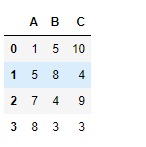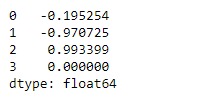Python是進行數據分析的一種出色語言,主要是因為以數據為中心的python軟件包具有奇妙的生態係統。 Pandas是其中的一種,使導入和分析數據更加容易。
Pandas dataframe.corrwith()用於計算兩個DataFrame對象的行或列之間的成對相關。如果兩個 DataFrame 對象的形狀不同,則對應的相關值將為NaN值。
用法: DataFrame.count(axis=0, level=None, numeric_only=False)
參數:
other: DataFrame
axis:0或“索引”用於按列計算,1或“列”用於按行計算
drop:從結果中刪除缺少的索引,默認返回所有的並集
返回:相關:係列
注意:變量與自身的相關性為1。
範例1:采用corrwith()函數查找沿行軸的兩個 DataFrame 對象之間的相關性
# importing pandas as pd
import pandas as pd
# Creating the first dataframe
df1 = pd.DataFrame({"A":[1, 5, 7, 8],
"B":[5, 8, 4, 3],
"C":[10, 4, 9, 3]})
# Creating the second dataframe
df2 = pd.DataFrame({"A":[5, 3, 6, 4],
"B":[11, 2, 4, 3],
"C":[4, 3, 8, 5]})
# Print the first dataframe
print(df1, "\n")
# Print the second dataframe
print(df2)

現在,沿著行軸找到兩個數據幀的列之間的相關性。
# To find the correlation among the
# columns of df1 and df2 along the row axis
df1.corrwith(df2, axis = 0)輸出:

輸出序列分別包含兩個 DataFrame 對象的三列之間的相關性。
範例2:采用corrwith()函數查找沿列軸的兩個 DataFrame 對象之間的相關性
# importing pandas as pd
import pandas as pd
# Creating the first dataframe
df1 = pd.DataFrame({"A":[1, 5, 7, 8],
"B":[5, 8, 4, 3],
"C":[10, 4, 9, 3]})
# Creating the second dataframe
df2 = pd.DataFrame({"A":[5, 3, 6, 4],
"B":[11, 2, 4, 3],
"C":[4, 3, 8, 5]})
# To find the correlation among the
# columns of df1 and df2 along the column axis
df1.corrwith(df2, axis = 1)輸出:

輸出序列分別包含兩個 DataFrame 對象的四行之間的相關性。
相關用法
- Python pandas.map()用法及代碼示例
- Python Pandas Series.str.len()用法及代碼示例
- Python Pandas.factorize()用法及代碼示例
- Python Pandas TimedeltaIndex.name用法及代碼示例
- Python Pandas dataframe.ne()用法及代碼示例
- Python Pandas Series.between()用法及代碼示例
- Python Pandas DataFrame.where()用法及代碼示例
- Python Pandas Series.add()用法及代碼示例
- Python Pandas.pivot_table()用法及代碼示例
- Python Pandas Series.mod()用法及代碼示例
- Python Pandas Dataframe.at[ ]用法及代碼示例
- Python Pandas Dataframe.iat[ ]用法及代碼示例
- Python Pandas.pivot()用法及代碼示例
- Python Pandas dataframe.mul()用法及代碼示例
- Python Pandas.melt()用法及代碼示例
注:本文由純淨天空篩選整理自Shubham__Ranjan大神的英文原創作品 Python | Pandas dataframe.corrwith()。非經特殊聲明,原始代碼版權歸原作者所有,本譯文未經允許或授權,請勿轉載或複製。
